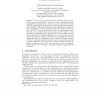Free Online Productivity Tools
i2Speak
i2Symbol
i2OCR
iTex2Img
iWeb2Print
iWeb2Shot
i2Type
iPdf2Split
iPdf2Merge
i2Bopomofo
i2Arabic
i2Style
i2Image
i2PDF
iLatex2Rtf
Sci2ools
102
Voted
CAIP
1999
Springer
1999
Springer
Optimized Fast Algorithms for the Quaternionic Fourier Transform
Abstract. In this article, we deal with fast algorithms for the quaternionic Fourier transform (QFT). Our aim is to give a guideline for choosing algorithms in practical cases. Hence, we are not only interested in the theoretic complexity but in the real execution time of the implementation of an algorithm. This includes oating point multiplications, additions, index computations and the memory accesses. We mainly consider two cases: the QFT of a real signal and the QFT of a quaternionic signal. For both cases it follows that the row-column method yields very fast algorithms. Additionally, these algorithms are easy to implement since one can fall back on standard algorithms for the fast Fourier transform and the fast Hartley transform. The latter is the optimal choice for real signals since there is no redundancy in the transform. We take advantage of the fact that each complete transform can be converted into another complete transform. In the case of the complex Fourier transform, th...
Related Content
| Added | 03 Aug 2010 |
| Updated | 03 Aug 2010 |
| Type | Conference |
| Year | 1999 |
| Where | CAIP |
| Authors | Michael Felsberg, Gerald Sommer |
Comments (0)

